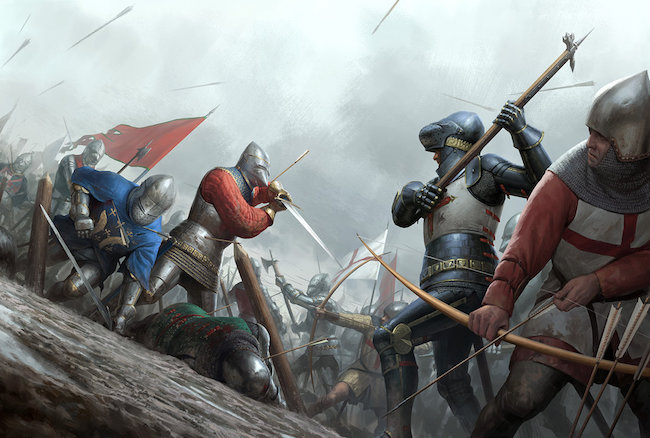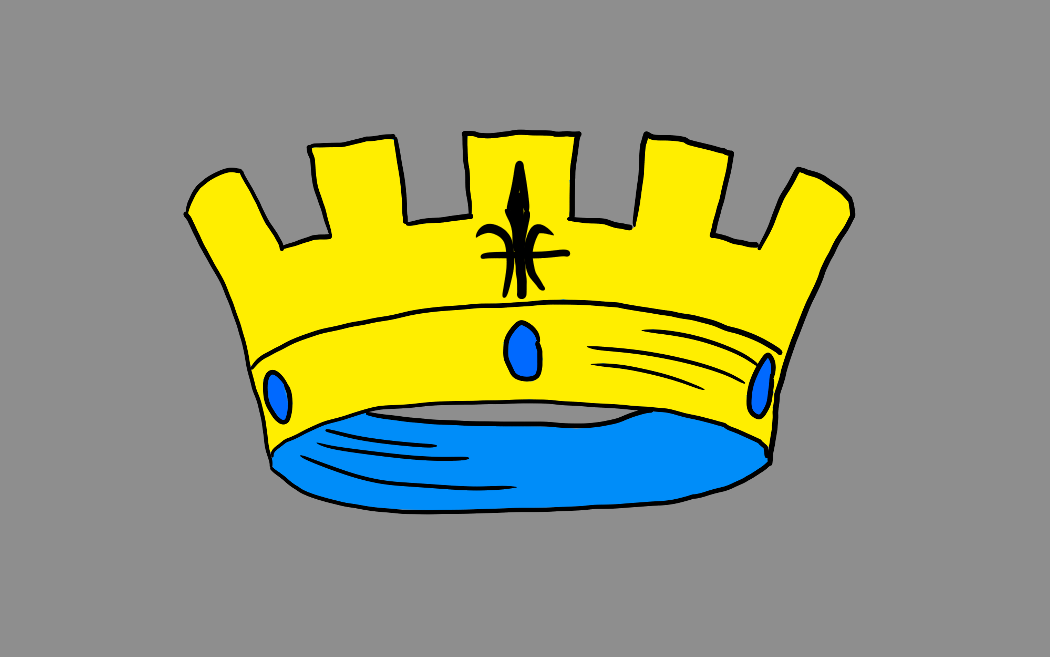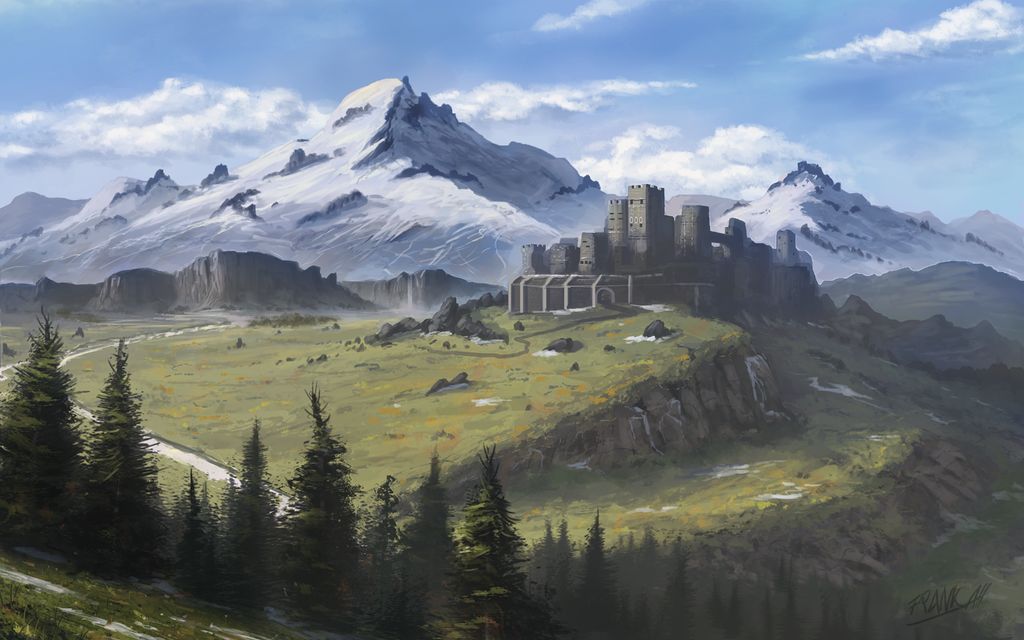Kingdom of Goth
"Oh, those Goths? They are a stuffy folk, insistent on naming everything after themselves. At the agreement for the formation of the Confederation, they insisted it would be called 'Gothai' since they created the idea. Now, take that instance and apply it to every citizen within that pretentious kingdom. That is the Kingdom of Goth for you." - Queen Durkavna of Icenglav, recalling the history of the Confederation.The Kingdom of Goth , currently known as Larian by it's citizens, was a sovereign and monarchial feudal state situated in the regions of Halfia, Fenestein, and Manneruck. It neighbored the Kingdom of Lysandus to its west, and was part of the Confederation of Gothai.
History
Early History
According to the earliest Mountain Dwarf histories, the first "Kells" arrived in the region of Halfia as a sect of the Kells. They were viewed as barbarians who raided some of the halfling villages. These Kells were divided into a few sects: the Nord, the Dane, the Icenglav, and the Goths. The "Goths" were called as such because the most notorious of their kings, Vincent of Goth, successfully fought off some of the Dwarves who tried to drive them away from Halfia. Evidently, the tyrant Vincent of Goth was proclaimed the first King of the Goths, completely autonomous from Dwarven rule, upon the continent of Eiren in the year 2300. He ruled from the city of Diede-Hofen in those days. He was seen as a competitor to Peotrev the Peaceful in Icenglav. However, not all the Goths were unified under Vincent's dynasty. Particularly, the grand city of Fenestein was built by four Gothain knights who bound their swords together in a hot forge. The city was thus deemed the "City of the Four Swords" and was co-ruled by each. The third kingdom, Manneruck, was ruled by the Dwarves who viewed both kingdoms of Diede-Hofen and Fenestein to be threats to their soverignty. Thus, sometime in the century of 2500, the Mountain Dwarves of Manneruck and the Mountain King warred with the two human kingdoms. Evidently, the dynasty of Fils-Vincent and the city of Fenestein temporarily allied themselves to face the threat of the dwarves. Thus, for centuries, Manneruck, Fils-Vincent, and Fenestein fought each other for dominance.Domination of Fenestein
Eudes Mane, one of the Kings of Fenestein, proclaimed himself as the High King of the Goths and tried to conclude the conquest of the Gothic kingdoms and the region of Manneruck.
After 500 years of fighting, the city of Four Swords came out on top around the year 3000. One of the kings of Fenestein, named Eudes Mane, betrayed the others and declared himself the High King of the Goths. Then, gaining the support of the people of Fenestein, he betrayed Diede-Hofen and invaded their land. This gave the Dwarves of Manneruck a moment to strike. However, Eudes outmaneuvered the Mannerucks and defeated them at the River of Courtia. Then the armies of the Kingdom of Fenestein laid siege into Diede-Hofen and claiming the city as their own. High King Eudes was recognized by the other human kingdoms of Keller, Anfeld, and Icenglav, leading the Mane dynasty to have their power unchallenged. However, modern chronicles only consider this kingdom to merely be the "Kingdom of Fenestein" instead of Goth despite Eudes Mane proclaiming himself as such.
After the death of High King Eudes Mane, however, the expansions of the Kingdom of Fenestein fell apart. The title of "High King of the Goths" was disputed toward Eudes son, Robert Mane, and the city of Diede-Hofen proclaimed that they no longer recognized the Mane Dynasty as their rulers. The lands went back to warring each other while the Mane dynasty tried to remain in power for as long as possible. They remained in power for around 300 years, until the dynasty grew weak enough to be overthrown by the Count of Perre, Phillipe. Phillipe thus called himself the King of Fenestein and allowed Diede-Hofe to regain their independence.
More in-fighting between Manneruck, Fenestein, and Diede-Hofen kept the region of Goth vulnerable to their enemies for another 6 centuries. Then, in the year 4003, the Dwarven Nords and the Manneruck invaded Fenestein, and the House of Perre was killed and overthrown. Now, only Diede-Hofen remained the independent human kingdom as the Dwarves asserted more of their power. Thus was the end of the first domination of Fenestein. The Kingdom of Norden ate up Manneruck as well, creating the Empire of the Nords, which terrified the Danen, the Icenglav, and the Diede-Hofen Goths.
The Great Northern War
In the first version of an alliance between the Gothic tribes of Eiren was formed by the king of Icenglav, named Nicolai VII, in the year 4050. Nicolai VII gathered the King of Danen named Leuswig and the King of Diede-Hofen named Gilroy Gilbertine. King Gilroy attested to Nicolai VII that his people, the Goths, desired a true unification of their people but the Norden forbid that. The three kingdoms thus shook hands in the city state of Avenve where they met, and agreed to go to war with the Norden.
by Triternion
"All For One, and One for All!" - The Reign of "Queen Percival"
But the dominance of the Dwarves did not last very long. Within the city of Laketown in Halfia in the year 4210, a teenaged peasant woman named Percivia foresaw a vision of the Gothans reclaiming their heritage and being united under one human crown. At first, Percivia tried to make herself look like a man as a knight, calling herself "Sir Percival" and spoke of revolution. She soon found that the people of Laketown found it more fascinating that a peasant woman could lead their rebellion, and was open about her feminine identity. Yet she was still called "Sir Percival" by the common folk. Evidently, the rebellious fervor began to spread across Manneruck, and the Dwarven King Dirge tried to put it down. However, he was soon found that the common people in his city had risen up, and he was overthrown. Sir Percival was placed upon the throne, with the common folk crying out her name was "Queen Percival!" to which she responded,"Yes! Listen, dear Goths! No longer shall we be ruled by the Dwarves of the Mountains. We shall return to the might of Vincent Goth and reclaim the land that is rightfully ours! All of the land for one kingdom, and one kingdom for all the goths! All for one, and one for all!"
Days after this speech was proclaimed, King Dirge found voice with the Dwarven Emperor of the Norden, named Nordfili. Nordfili was angered and sent his army towards the city of Manneruck. Queen Percival then took an Oath of Conquest and proclaimed that the Dwarves would suffer for their years of oppression toward the Goths. She rallied the citizens of Diede-Hofen and Fenestein, and then had her army flee the city of Manneruck while it was besieged by the Norden. Queen Percival's army was chased toward a canyon near Bolderun, where the Dwarves thought they would surely defeat the united Gothan army. However, a strange turn of events took place, where the canyon proved a choke point for the dwarves. The Battle of Percival's Rock commenced in the year 4214, leading to a slaughter toward the Dwarves as the united Gothans flanked them in a sneak attack. One of Queen Percival's knights, George Mane, captured Emperor Nordfili, and the queen pressed her demands. The Norden Emperor scoffed at the treaty and signed it. Then, a year later, he broke the treaty before Queen Percival could stabilize the region.
However, this time, the Danen and the Icenglav remembered their once-forgotten alliance and assisted the queen. The Goths, Danes, and Icenglav joined together at Vatlstein as the Dwarven Emperor attacked once more in a wide valley. The Emperor was promptly defeated by the Ice King of Icenglav summoning a storm, leading his armies to be wiped from the battlefield. This time, the Emperor meant his treaty, to which Queen Percival demanded that Fenestein, Diede-Hofen, and Manneruck would be placed under her control. The Emperor signed the treaty, making the young woman the official Queen of the Goths in the year 4215.
The rest of Queen Percival's reign involved organizing the entirety of the realm under her complete control, and she made Fenestein her realm capitol to rule from while the Mane dynasty was allowed to hold Dukedom. Then, in the year 4256, Queen Percival passed away and her crown was left to her son, also named Percival. Thus, the Percival dynasty was set in place, to lead the Kingdom of Goth for centuries to come.
Joining the Confederation of Gothai
In the year 5370, the Norden sacked the City-State of Avenve and angered the Kingdom of Goth. Icenglav and Danen got involved in the conflict, fighting each other once again, until the Elven Gaels and the Kellerites began to attack the five nations during their time of weakness. During this, the kings of each nation set aside their battling and decided they needed to stop the infighting. The King of Goth at the time, Charles Percivaline III, suggested creating a confederation to keep each other safe, as all of them were rather weak nations on their own. Thus, they unified into a single confederation and fought back the Gaels and the Kells. The Confederation would remain intact through diplomatic means afterwards, though King Charles insisted the confederation be called "Gothai" since they came up with the idea. Thus, to this day, the Kingdom of Goth remains within the Confederation, and remains a great ally to their eastern neighbor of Lysandus in the times of trouble, including the Dragon Crises and their civil wars that commenced.Structure
The Kingdom of Goth is largely a feudalistic system, with a single monarch in power who must listen to their vassal dukes. The King, currently of the Percival Dynasty, operates the army and economic system, as well as passes charters for the nobles to agree or disagree too. But ultimately, the king has absolute decision on the way the kingdom is run.
Culture
The Goths are considered "pretentious" when other cultures talk about them. They are a people of high standards, being the first to criticize their neighbors and take credit for most revolutionary ideas. This is solely because the Goths are a society based on merit, not class. Thus, the criticism is to construct better Gothan citizens. This idea is called a "Social Education" to them, so that their children may learn. It is with a heavy hand but otherwise it allows them to pass on stern knowledge and scold incompetence.
This also goes to their food choices. Most Gothain food is rich with flavor, and they enjoy cultivating wines and cheeses and breads. Their cooking is considered to be, perhaps, the best on the continent. They are also a society bent on artistic tendencies, lavishing their churches and government buildings with beautiful and colorful mosaics. In contrast, they tend to hate militarism in their nation, despite how their past has shown much love for conquest and glory. Starting the standard with Queen Percival, the Gothans believe war is only for self preservation instead of hunger for power, unlike what their neighbors seem to think.

All for One, and One for All!
The extent of Goth's diplomatic borders in the year 1A 5750. Within the confederation, the borders are considered wider and a thin stretch reaches into the road toward Avenve. However, that border is merely recognized for confederation sake. To outsiders, these are the natural borders of Goth.
Remove these ads. Join the Worldbuilders Guild







Comments